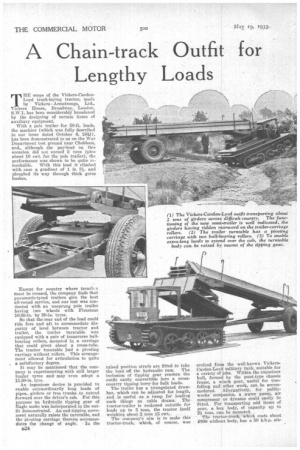A Chain-track Outfit for Lengthy Loads
Page 38

Page 39

If you've noticed an error in this article please click here to report it so we can fix it.
THE scope of the Vickers-CardenLoyd track-laying tractor, made by VickersArmstrongs, Ltd., "Vickers House, Broadway, London, S.W.1, has been considerablY broadened by the designing of certain items ef auxiliary equipment.
With a pole trailer for 50-ft. loads, the machine (which was fully described in our issue dated October 6, 1931), has been demonstrated to us on the War Department test ground near Chobham, and,, although, the pay-load on this occasion did not exceed 2 tons (phis about 10 cwt. for the pole trailer), the performance was shown to be quite remarkable. With this load it climbed with ease a gradient of 1 in 31, and ploughed its way through thick gorse bushes.
Except for country where trencleA, must be crossed, the company finds that pneumatic-tyred trailers give the best all-round service, and our test was conducted with an unsprung pole trailer having two wheels with Firestone 10.50-in. by 20-in. tyres.
So that the rear end of the load could ride fore and aft to accommodate disparity of level between tractor and trailer, the trailer turntable was equipped with a pair of transverse ballbearing rollers, mounted in a carriage that could pivot about a cross-tube. The tractor turntable .liad a pivoting carriage without rollers. This arrangement allowed for articulation to quite a satisfactory degree.
It may be mentioned that the company is experimenting with still larger trailer tyres and may even adopt a 15.50-in. tyre.
An ingenious device is provided to enable extraordinarily long loads of pipes, girders or tree trunks. to extend forward over the driver's cab. For this purpose an hydraulic tipping gear of Eagle make was incorporated in the outfit demonstrated. An end-tipping movement naturally raises the turntable, and the pivoting carriage thereon accommo dates the change of angle. In the 1324 raised position struts are fitted to take the load off the hydraulic ram. The inclusion of tipping gear renders the outfit easily convertible into a crosscountry tipping lorry-for bulk loads.
The trailer has a triangulated drawbar, which can be adjusted for length, and is useful as a ramp for loading such things as cable drums. The tractor-trailer is reckoned suitable for loads up to 5 tons, the tractor itself weighing about 2 tons 15 cwt. The company's aim is to make this tractor-truck, which, of course, was evolved from the well-known VickersCarden-Loyd military tank, suitable for a variety of jobs. Within the capacious hull, formed by the punt-type chassis frame, a winch gear,, useful for treefelling and other work, can be accommodated. Alternatively, for publicworks comPanies, a water pump, air compressor or dynamo could easily be fitted. For transporting odd items of gear, a box body, of capacity up to .24. tons, can be mounted. • The tractor-truck, -which costs about £800 without body, has a 50 b.h.p. six cylindered engine, this driving, by way of a normal clutch and tive-speed gearbox, through two multi-plate clutches, large sprockets, on a front crossshaft, which engage with the pin-jointed chain tracks. At each side are two sprung bogies on ball-bearing pivots, so that the weight rests on the track through eight solid-rubber-tyred wheels. Steering is effected by declutching and braking either sprocket shaft.
The vehicle will cross a 4-ft. trench or ford a stream 2 ft. 6 ins. deep.. It will carry 2 tons 2 cwt. up a 1-in-3.2 gradient, or travel on a level road at 15 m.p.h. to 25 m.p.h., the fuel consumption being at about eyi
With track-laying vehicles the question naturaly arises as to the length of life of the tracks. Vickers-Armstrongs, Ltd., reckons upon a 3,000-mile life, although cases are reported of much greater mileages, even in the most severe classes of work. The track links ate of steel and have claws extending inward which, in addition to forming a -guide for the solid-rubber-tyred bogie wheels, make pockets which 'give a
better grip upon soft ground. The joint pins are burred over at the ends.;




























































































